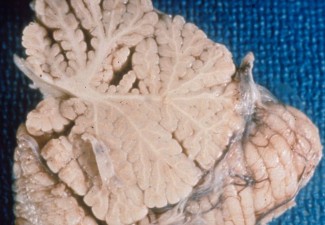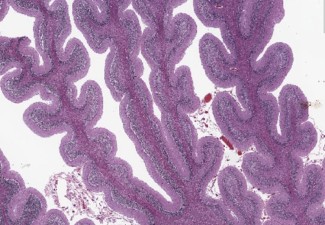In this chapter, you will learn and review high-yield aspects of toxicology and metabolic disease that are frequently tested on board examinations and the RITE®. Real patient pathology and MRI images, flashcards, and a question bank are included for a complete learning experience!
Authors: Steven Gangloff MD, Brian Hanrahan MD
Chapter Multimedia Content
Table of Contents
Loading table of contents...
Drugs of Abuse
Alcohol
- Alcohol’s mechanism of action is not entirely understood, but it acts as an agonist of gamma-aminobutyric acid (GABA, the primary inhibitory neurotransmitter in the CNS) .
- Acute intoxication:
- Presents with slurred speech, incoordination, unsteady gait, and nystagmus.
- Chronic EtOH:
- Can cause vitamin deficiencies such as B12 deficiency and B1 deficiency-related Wernicke’s encephalopathy and Wernicke-Korsakoff disease. See below regarding vitamin deficiencies.
- Subcortical alcohol-related dementia.
- Cerebellar atrophy
- Marchiafava-Bignami disease
- Corpus callosum damage.
- Presents with a sudden onset of stupor, coma, and seizures. Can also present with dementia, gait problems, psychiatric disturbances, incontinence, hemiparesis, aphasia, and apraxia of the left hand (due to callosal disconnection).
Methanol
- Ingested as an alcohol substitute and in suicide attempts.
- Methanol → formaldehyde → formic acid.
- Presents with a headache, confusion, hyperventilation and anion gap metabolic acidosis, and visual deficit.
- Pathology: Necrosis and hemorrhage of the putamen and toxic optic neuropathy.
- Treatment: bicarbonate and fomepizole are first-line. Ethanol works similarly to fomepizole. Dialysis may also be needed.
Ethylene Glycol
- Presents with edema and petechial hemorrhages secondary to calcium oxalate deposits within vessels.
PCP
- Presents with nystagmus, hypertension, tachycardia, muscle rigidity, dysarthria, decreased response to pain, and seizures.
Bath salts/methylenedioxypyrovalerone (MDPV)
- Presents with hypertension, tachycardia, delusions, hallucinations, and violent behavior.
Opioids
- Acute overdose will present with miosis (constricted pupils), hypotension, bradycardia, and decreased respirations.
- Can be treated with naloxone.
- Constipation can occur with chronic use.
- Long-term treatment for opioid dependence includes naltrexone (long-acting opioid antagonist), methadone, or buprenorphine.
- Withdrawal symptoms include lacrimation, rhinorrhea, diaphoresis, mydriasis, and yawning.
- Clonidine (alpha 2-receptor agonist) can blunt the sympathetic symptoms associated with opioid withdrawal.
- Meperidine is metabolized into a neurotoxic metabolite that can provoke myoclonus, tremors, and seizures.
Benzodiazepines
- Mechanism: Increases frequency of GABAA channel opening.
- Barbiturates, on the other hand, increase the duration of GABAA opening.
- Most benzodiazepines are metabolized by the cytochrome p450 system.
- Lorazepam, oxazepam, and temazepam, however, undergo direct glucuronidation without cytochrome p450 metabolism and therefore can be used in patients with renal or hepatic dysfunction with only minor effects on pharmacokinetics.
Cocaine
- Works by inhibiting dopamine reuptake and increasing dopamine concentrations in the nucleus accumbens. Also inhibits the reuptake of serotonin and norepinephrine.
- Acute intoxication presents with mydriasis, euphoria, and tachycardia.
Amphetamines
- Amphetamine intoxication presents similarly to cocaine, except the mechanism of action is through both the direct release of dopamine and norepinephrine and the inhibiting of reuptake.
Nitrous Oxide (inhaled)
- Exam: progressive paresthesias secondary to myelopathy of the posterior and lateral columns, mimicking B12 deficiency. Additional symptoms include ataxia, weakness, and positive Lhermitte’s sign.
- Pathophysiology: Irreversible oxidization of methylcobalamin which interferes with the vitamin B12-dependent conversion of homocysteine to methionine as well as methyl-malonyl CoA into succinyl CoA. Homocysteine levels will be elevated. Treat with methionine supplementation.
Glue (Toluene)
- Inhalation of toluene causes myelin damage and diffuse leukoencephalopathy.
“Chasing the Dragon”
- Inhalation of heated heroin or morphine fumes. Can produce a toxic leukoencephalopathy.
Supplements, Botany, & Foods
Log in to View the Remaining 60-90% of Page Content!
New here? Get started!
(Or, click here to learn about our institution/group pricing)1 Month Plan
Full Access Subscription
$142.49
$
94
99
1 Month -
Access to full question bank
-
Access to all flashcards
-
Access to all chapters & site content
3 Month Plan
Full Access Subscription
$224.98
$
144
97
3 Months -
Access to full question bank
-
Access to all flashcards
-
Access to all chapters & site content
1 Year Plan
Full Access Subscription
$538.47
$
338
98
1 Year -
Access to full question bank
-
Access to all flashcards
-
Access to all chapters & site content
Popular
Loading table of contents...
Loading table of contents...



